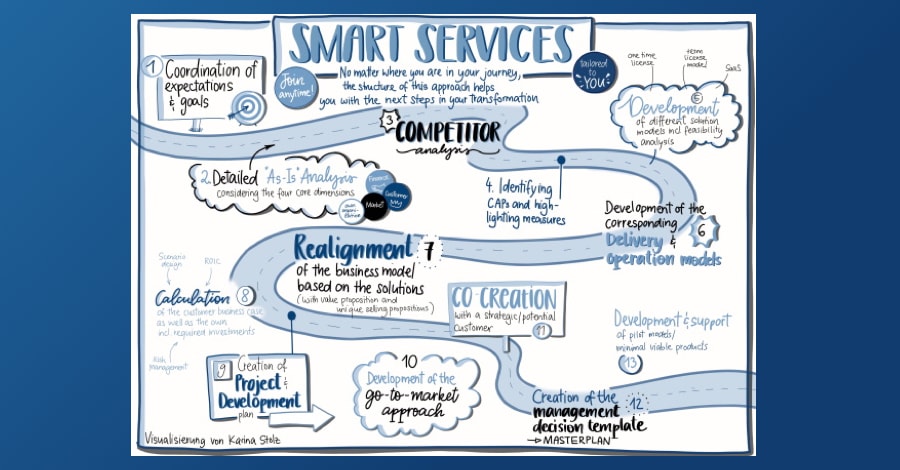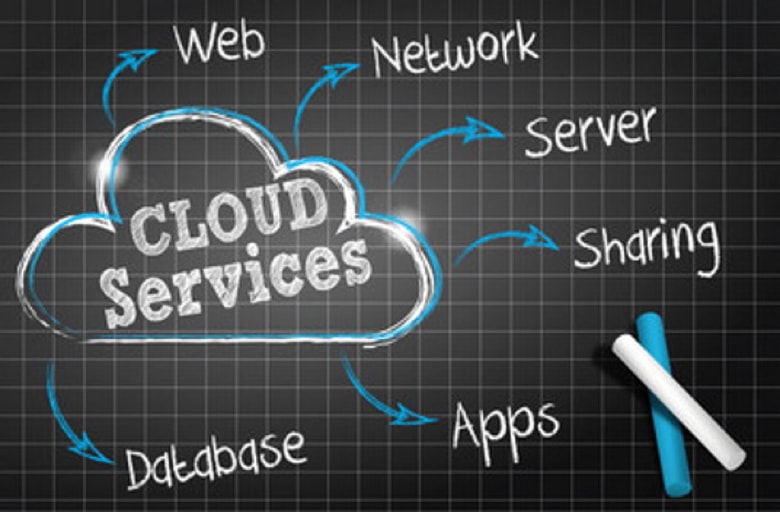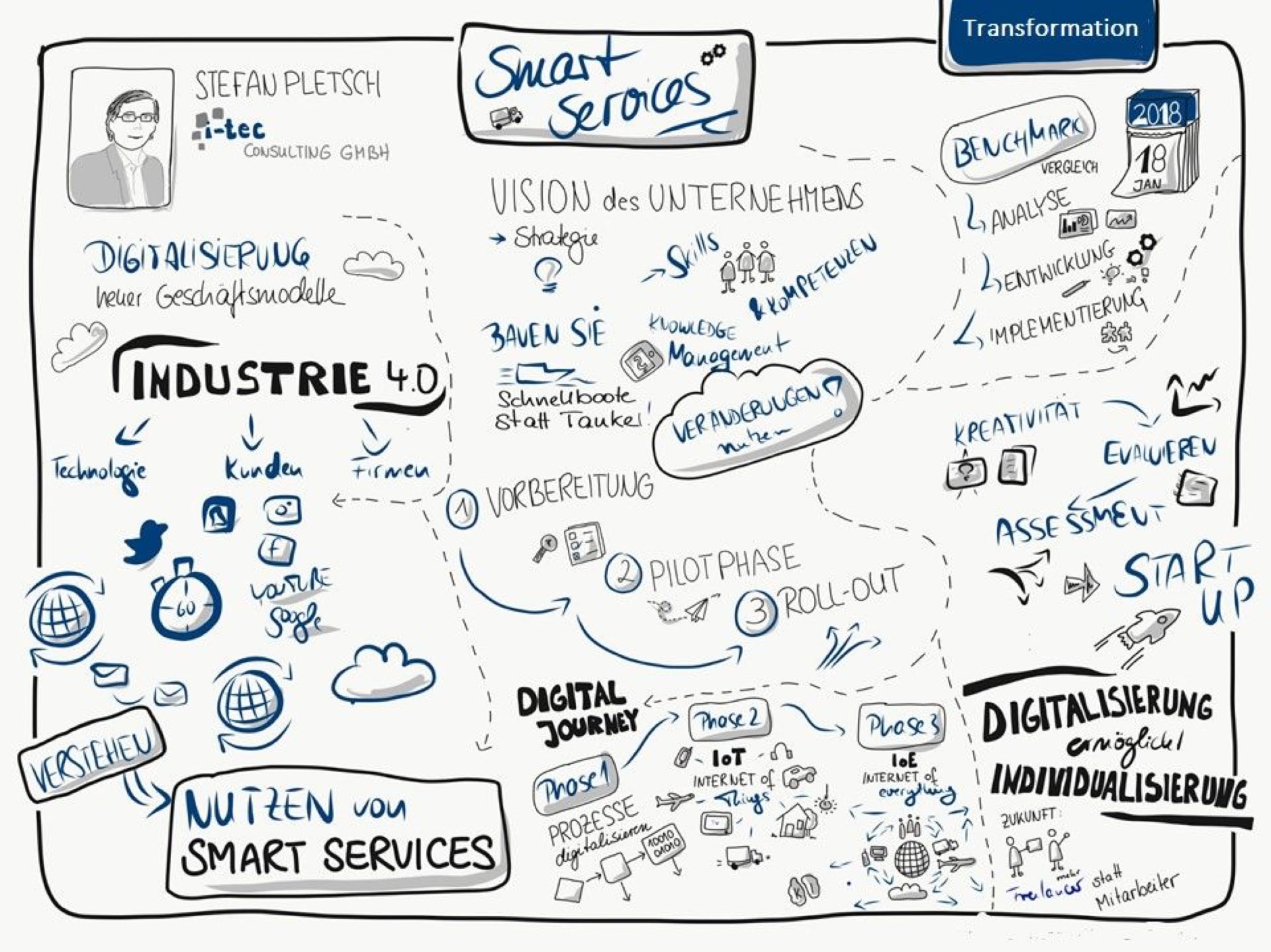
The digital transformation of business models in a practical and successful way
The business world is only at the beginning of an exponential development, almost all industries are experiencing the digital transformation and yet it feels as if we have already spent many years on it.
Nothing is as constant as change – Heraclitus
With the introduction of smart phones and tablet PCs, we have seen the first leap in innovation, followed by big data and analytics. Since then, smart services in the form of applications (apps) have become part of our everyday lives. Cloud computing has become standard. A complete separation of pure B2B and B2C business, as was often the case, no longer exists and a further fusion is taking place.
Therefore, understanding the customers and their needs is of great importance.
More and more applications in their final form are affecting the end customer, whether at home, in mobility, device medicine or in finance with real-time information and paperless processes. The possibilities of networking across all areas of life and its revolutionary development will only become a reality with the introduction of the next generation of mobile communications (5G).
Constant need for change
The use of 5G technology in networked and data-driven processes will enable solutions with a 100 times higher data rate, 1000 times higher capacity and 90% lower power consumption. This makes fundamentally new business models possible and requires a paradigm shift in many industries.
Open, cloud-based platforms enable new business models and thus change consumer behavior and delivery models in a global, networked world.
Open, cloud-based platforms enable new business models and thus change consumer behavior and delivery models in a global, networked world. The basis for this is provided by the data of users of applications as well as of machines (IOT applications) and their geo-tracking data, some of which are available in real time. Numerous companies have already adapted to this development and are working intensively on internal and external networking.
The question of how and where data is stored and who has access to this data is still openly discussed in the companies. Ultimately, the end customer has already decided to use modern media.
How are companies currently preparing for the evolution / revolution that lies ahead?
There are already companies that are vehemently promoting digitisation. This group of companies has already split up in principle, one part concentrating on cloud-based business models with open platforms, the other part running a traditional but also networked product and service business. One example is the Claas company from Harsewinkel near Gütersloh, a major European manufacturer of agricultural machinery.
In addition, there is the group of evolution-driven companies that continue their existing product range with the aim of migrating it gradually in the medium term, such as BMW or Daimler-Benz with electric vehicles for sustainable mobility.
The mobility offer from Uber, a US service company that offers online passenger transport services worldwide, is radical. The UberX and UberBlack services refer passengers to rental cars with drivers, while UberPop refers them to private drivers with their own cars. The referral is done via a mobile app or website.
A third group has completely decoupled itself from its core business – such as IBM – and controls via application-driven, industry-specific solutions based on data analytics and cloud-based.

The fourth group is still in the very early stages of digitisation and must therefore start with the basics and catch up strongly. Examples can be found in the public sector, handicraft and construction, stationary trade and traditional mechanical engineering. Here, data must be prepared intelligently and data-based solutions must be found via process transparency, which are then integrated into an end-to-end process landscape.
Digital transformation in practice –“from product driven business to data driven business”
In the following we provide an insight into one of our projects, which takes place in the environment of digital transformation:
“Transformation of the business model from a “mere” product provider to a holistic data-driven service provider”
The constantly accelerating technological change, combined with the possibilities of increasing digitization, makes it necessary to question and, if necessary, correct existing business models or initiate the change towards digital business models. In addition to a clear vision, i.e. what is the goal of the transformation, a clear investment strategy, the selection of the right digital technologies and the operational model are of decisive importance. The success of the transformation essentially depends on the following factors:
- Professional data management
- Lean innovation processes
- Deep understanding of customer needs
- Early integration of employees in the development and change processes
- Sufficient availability of resources

The project background
The customer is currently in a highly competitive environment. Increasing competitive pressure and declining margins, coupled with ever higher customer demands for availability, transparency and response times in the event of faults. The ongoing core business presented him with the challenge of positioning himself successfully and sustainably for the future by developing digital services and business models.
To strengthen the team, external “know-how” in the form of consultants with many years of experience in the field of digital transformation with medium-sized companies and large corporations was brought in.
The initial situation
At the time of taking over the consulting mandate, a strategy was available on how to implement the transformation from product business to digital, data-based business models. The business processes of the various departments were not interlinked, and existing synergy potential was not exploited.
The business processes of the various departments were not interlinked, and existing synergy potential was not exploited.
The first digital solutions were available as “island solutions”, which were developed for individual customers. A digital end2end portfolio and a process-related network established across all departments were not available.
Proven approach
Based on the initial situation, we focused our activities – in coordination with the client – on the development of an extended strategy for digital transformation. This initiated the transformation of the business model from a pure product provider to a data driven service provider.
Our approach can be summarized in 13 steps:
- Coordination of expectations and goals
- Detailed “As-Is” analysis considering the 4 core dimensions (finance, customer, market and own organisation)
- Competitor analysis
- Identifying CAPs and highlighting measures
- Development of different solution models incl. feasibility analysis
- Development of the corresponding delivery and operation models
- Realignment of the business model based on the solutions
- Calculation of the customer business case as well as the own incl. required investments
- Creation of project and development plans
- Development of the “go-to-market approach
- Co-creation with a strategic / potential customer
- Creation of the management decision template
- Development and support of pilot models / minimal viable products

The core of the strategy was to build a global, modular and therefore scalable platform anchored in the cloud, in which all processes (end2end) are digitally mapped and the customer can use the optimal solutions according to his needs.
Various business models have been developed for this purpose, ranging from “one-time fees”, licenses and “transaction fees” (SaaS models) to “win-sharing” models.
The results are:
- New digital portfolio with focus on platform driven services
- Calculated business cases, which show an annual growth of 20% or enable savings potentials in the 2-digit range on the customer side
- Shift of revenues from product sales to transaction-based revenues and licensing income
- Roadmap for the development of further services and the internationalisation of the business, backed up by actions
- Winning strategic customers and building partnerships

Conclusion
The repositioning of a digital business can only be successfully implemented in a separate unit and company. This requires a fundamental change in the awareness of managers and the entire team (Change of Mindset). Clear communication top down and coaching for a limited time support the change process. With first pilots, ideally in a co-creation process with customers and suppliers, the proof of feasibility and profitability is worked out and a minimal viable product is developed. In this way, small successes become visible and the team develops a high level of identification with the new solutions and paths.
The future orientation and positioning of the digital business in a separate business unit led to more dynamics, shorter decision-making processes and a convincing market presence.
Digital solution modules can be used across all industries, such as in the chemical industry, in the automotive environment or in logistics and its networks.
“Creating and living a community with customers leads to sustainable business”.


